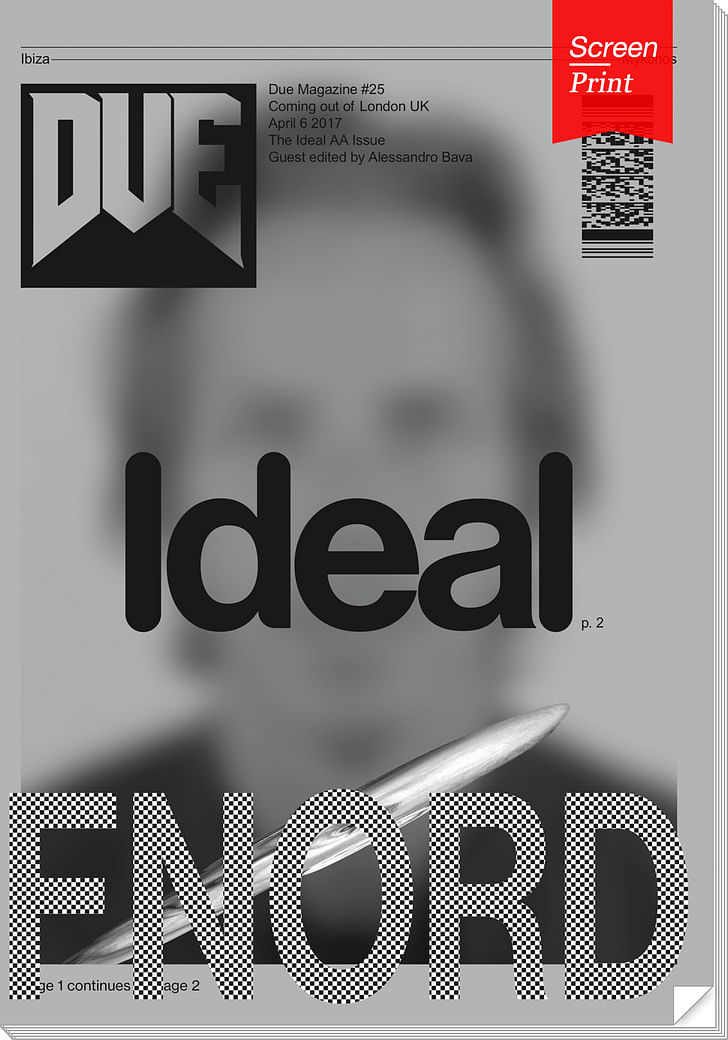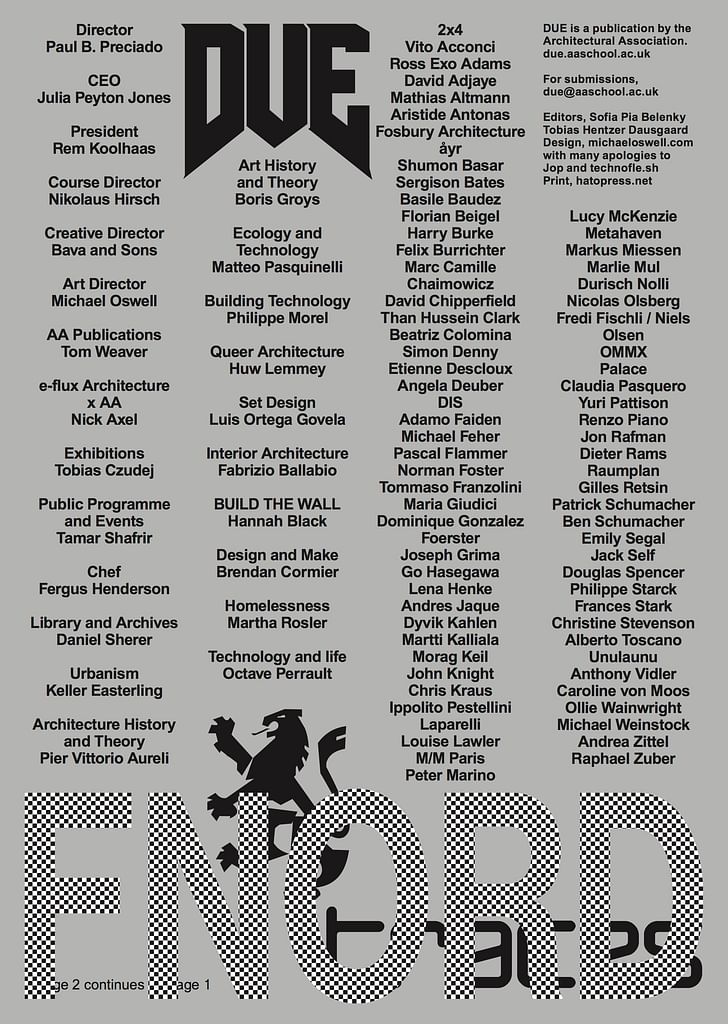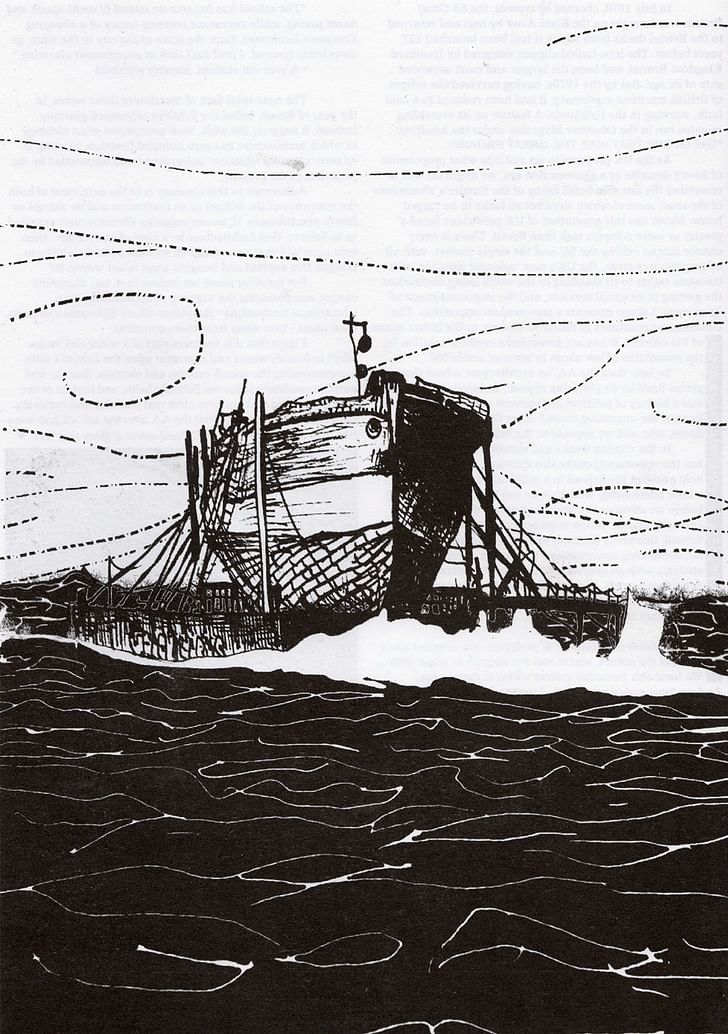

One of the preeminent schools of architecture in the world, the Architectural Association of Architecture (AA) in London is in the midst of some significant changes. Brett Steele, the director of the school, is heading out to Los Angeles where he will serve as Dean of the UCLA School of Arts and Architecture. During this time of transition, the students and alumni of the AA have taken to the school’s weekly publication DUE, featured here as part of Archinect’s recurring series Screen/Print, to reflect on the past and project towards the future of the institution.
As a broadsheet, DUE is a bit unusual for Screen/Print, which showcases excerpts from journals and books as an experiment in cross-media translation. So for this iteration, we’re including two different issues of the periodical. The first is by Alessandro Bava, former student of the AA, head of the studio Bava & Sons, member of the art collective åyr, and editor of the ecology-focused zine Ecocore. A wish-list of Bava’s ideal version of the AA, this speculative piece is primarily visual, so we’ve featured the front as the cover image of this feature and included the back page below. The second piece is by current AA student Oskar Johanson. Johnson reflects on his view on the opportunities for the future of the AA.
“We hope these pieces among others will stir conversation around the structure and the future of the school, promoting these future discussions,” state Sofia Pia Belenky and Tobias Hentzer Dausgaard, editors of DUE.


The Glory That Was
By Oskar Johanson
In July 1970, cheered by crowds, the SS Great Britain was brought up the River Avon by tugs and returned to the Bristol docks from which it had been launched 127 years before. The iron-hulled clipper, designed by Isambard Kingdom Brunel, had been the largest and most advanced ship of its age. But by the 1970s, having survived the eclipse of British maritime supremacy, it had been reduced to a coal hulk, working in the Falklands. A feature on its crumbling remains ran in the Observer Magazine under the headline: “THE GLORY THAT WAS THE GREAT BRITAIN”.
So how does the AA, an architecture school that prides itself on its glittering alumni, its internationalism, and a history of political engagement and polemics, expect to meet the oncoming storm?
As the UK prepares to set sail into what proponents of Brexit describe as a glorious new era, we might do well to remember the fate that befell many of the Empire’s ‘champions of the seas’, most of which were not so lucky to be tugged home. Never has this generation of UK politicians faced a greater or more complex task than Brexit. There is every chance that in exiting the EU and the single market, with all other pressures given, the UK’s new ‘splendid isolation’ will translate rather to its standing in the world being diminished, the gutting of its social services, and the impoverishment of its citizens. Labour presents a non-existent opposition. The Government continues to refuse to commit to the future status of EU citizens. It has not presented a credible solution for the mountains of law about to become zombified.
So how does the AA, an architecture school that prides itself on its glittering alumni, its internationalism, and a history of political engagement and polemics, expect to meet the oncoming storm? After Brett Steele steps down, who will we appoint to the helm?
In the coming weeks and months, the AA community has the opportunity make this decision, and in doing help position the School in a politically fraught nation whose relationship with Europe has been imperilled. But before we advance, we must first assess the School as it currently stands. Below is an account of the Intermediate School, this being the limit of my own AA experience so far, combining conversations with other current ‘year out’ students with an overview of the current Intermediate School unit briefs. I leave it to those Diploma graduates and tutors across the board to add accounts from their own points of view.

‘I think the plurality of pedagogy has dropped since I joined the school, and it was not enough to begin with … We have this beautiful system which is super agile! And we have ended up with […] units which are obsessed very much with the same things, with a few exceptions.’ (a year out student, identity withheld)
Together with a presentation made before the term begins, the unit brief reflects the expectations tutors have of future students as well as the architectural philosophies of the tutors themselves. It is part of the School’s vaunted plurality, but, at least according to a few students I spoke to, not without its failures.
Ranging from the eloquent to the incoherent, the briefs appear diverse. But in those presented for the 2016/17 year, a handful of tendencies do recur. These include an insistence on architecture’s romantic and speculative capacity; the transformative (and inevitable) power of technology; the relevance of things called ‘form’, ‘space’, and ‘materiality’; the importance of context; and the promise of the power of drawing. Only three of the sixteen briefs state explicitly that the role of the architect herself will be subject to debate, and of those, only one is polemic enough to challenge the student to seriously countenance political activism.
All of these briefs were written months after the vote to leave the European Union.

‘The school has become an island of archi-speak and navel gazing, while enormous pressing issues of a changing European landscape, from the scale of the city to the state, go completely ignored. I find [its] lack of engagement alarming.’ (a year out student, identity withheld)
The near-total lack of mention of these issues, in the year of Brexit, belies the School’s celebrated plurality. Instead, it suggests the wide, tacit acceptance of an ideology in which architecture has zero political function, existing in its own ‘splendid isolation’ unburdened and untroubled by the pressures of the present.
For however much we believe in it, our discipline cannot communicate the urgency of architecture if its educational institutions—the places where discourse can be its most blunt—turn away from these concerns.
Adherence to this ideology is to the detriment of both the relevance of the School as an institution and its alumni as future practitioners. If, as our outgoing Director once enjoined us to believe, that architecture is ‘a kind of knowledge’, then how poor will that knowledge be without both the ability to critique this context and imagine ways to act within it?
For however much we believe in it, our discipline cannot communicate the urgency of architecture if its educational institutions—the places where discourse can be its most blunt—turn away from these concerns.
I hope that this becomes part of a wider and longer effort to frankly assess and comment upon the School’s state, complementing the search process and election, that the best possible candidate takes the School’s helm, and that he or she asks of students and teachers alike real plurality and radicality. Only then will we ensure that the AA does not sail off into a sea free of consequence, left to tell itself about a ‘glory that was’.

Screen/Print is an experiment in translation across media, featuring a close-up digital look at printed architectural writing. Divorcing content from the physical page, the series lends a new perspective to nuanced architectural thought.
For this issue, we featured two issues from DUE.
Do you run an architectural publication? If you’d like to submit a piece of writing to Screen/Print, please send us a message.
Writer and fake architect, among other feints. Principal at Adjustments Agency. Co-founder of Encyclopedia Inc. Get in touch: nicholas@archinect.com
No Comments
Block this user
Are you sure you want to block this user and hide all related comments throughout the site?
Archinect
This is your first comment on Archinect. Your comment will be visible once approved.